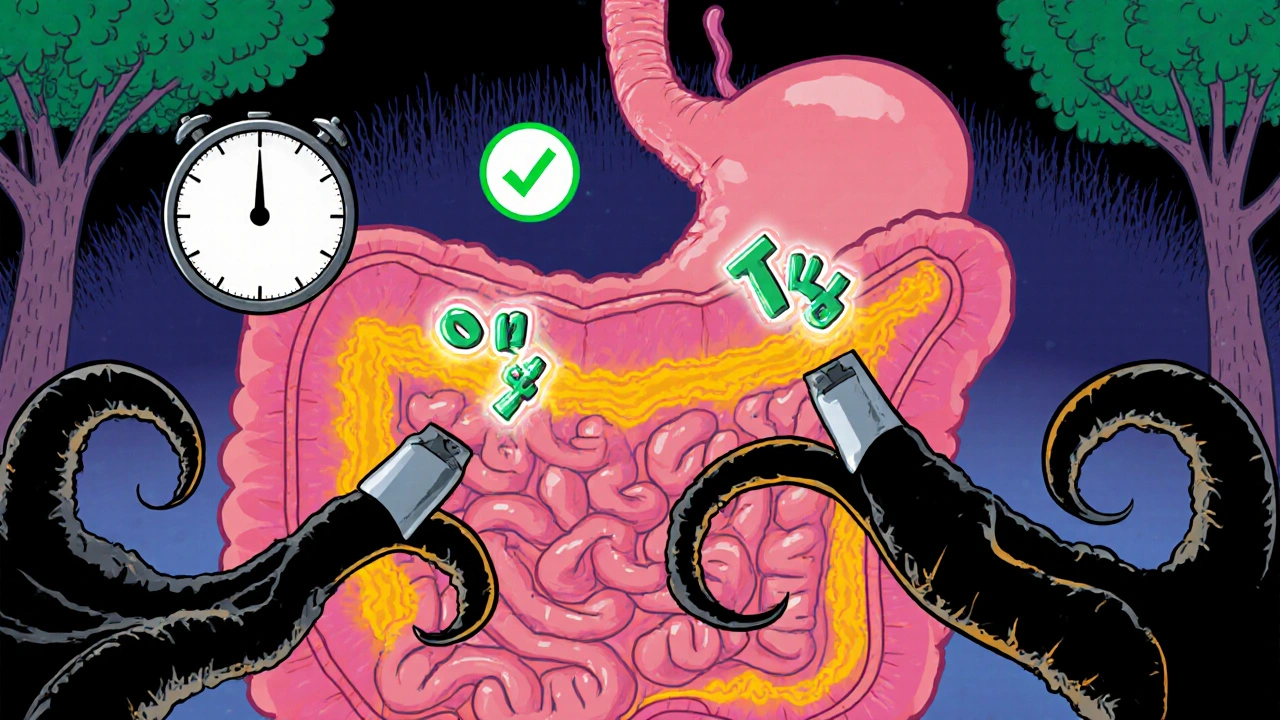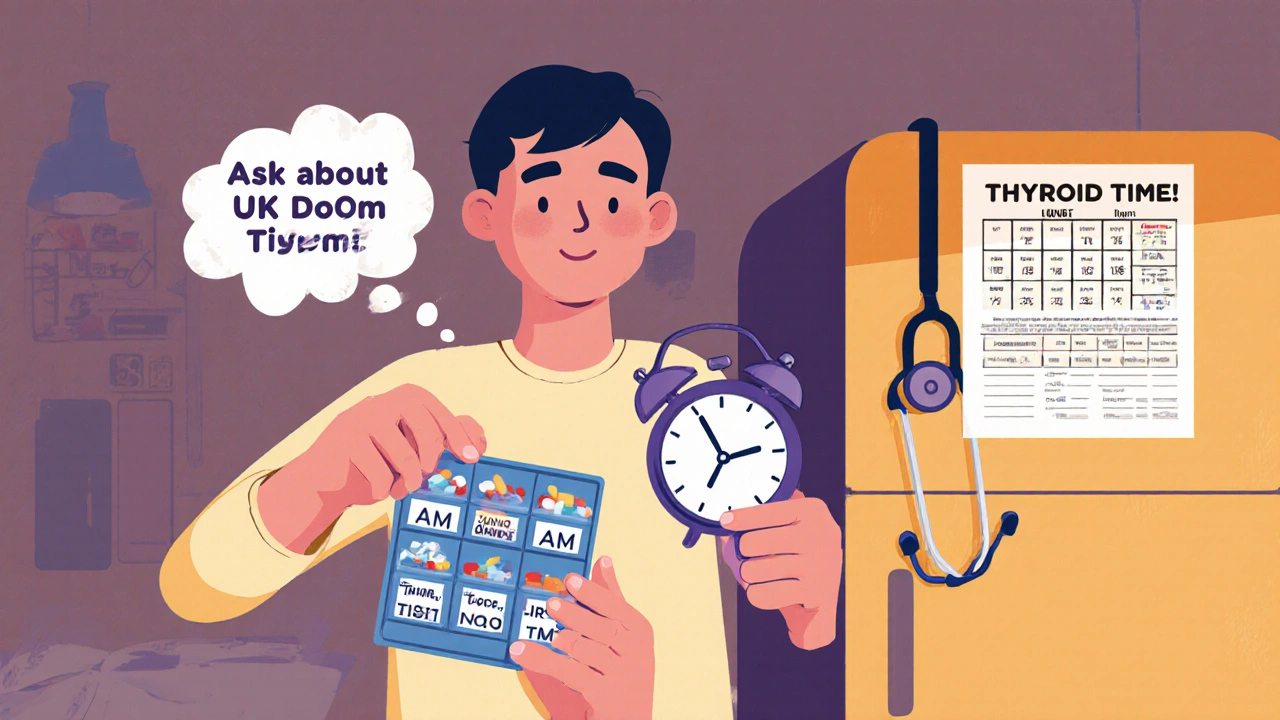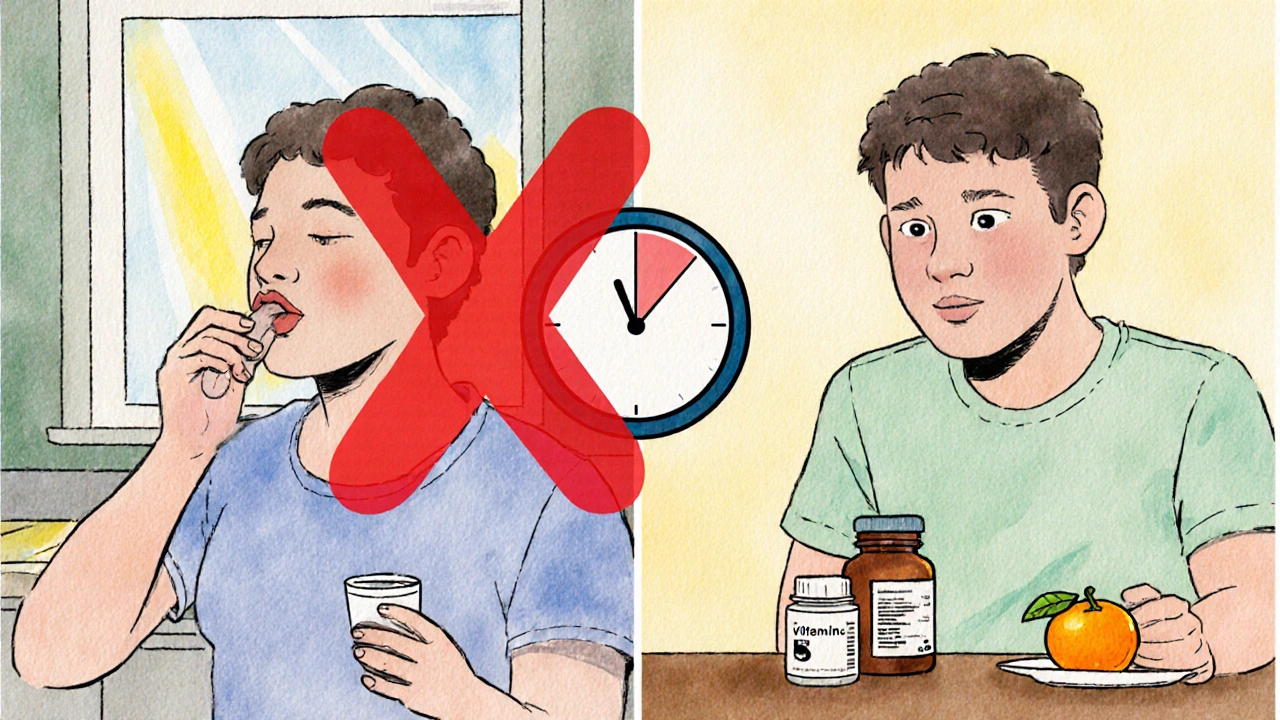Thyroid & Iron Timing Calculator
When to Take Iron with Levothyroxine
This tool calculates the optimal time to take iron supplements after levothyroxine to ensure maximum thyroid medication absorption. The medical consensus recommends a minimum 4-hour gap between these medications.
Your Medication Schedule
If you’re taking levothyroxine for hypothyroidism and also need iron supplements, you’re not alone. Millions of people in the U.S. are on both. But here’s the problem: if you take them at the same time, your thyroid medication might not work. Iron binds to levothyroxine in your gut, forming a chemical lock that stops your body from absorbing the hormone. The result? Your TSH levels spike, your fatigue gets worse, and you might even feel like your treatment has stopped working - even though you’re taking your pills.
Why Iron and Levothyroxine Don’t Mix
Levothyroxine is a synthetic version of the thyroid hormone T4. It’s designed to be absorbed in the upper part of your small intestine, where the environment is slightly acidic. Iron supplements - especially ferrous sulfate, the most common type - release iron ions that cling to levothyroxine molecules like magnets. This creates an insoluble complex that your body can’t absorb. Studies show this can slash levothyroxine absorption by up to 39%. That’s not a small drop. That’s enough to push your TSH from a normal 2.0 to a problematic 6.0 or higher.This isn’t new science. The first paper on this interaction came out in 1976. Since then, dozens of studies have confirmed it. The British National Formulary, NICE, and even the Synthroid manufacturer all agree: don’t mix them. Yet, a 2025 audit found that 84% of patients were taking both at the same time. That’s not because they’re careless - it’s because the timing rules are confusing.
The 4-Hour Rule: What the Experts Say
Most major medical guidelines say you need at least four hours between levothyroxine and iron. Here’s how it breaks down:- Take levothyroxine on an empty stomach, 30 to 60 minutes before breakfast.
- Wait at least four hours before taking iron.
- Or take iron at least four hours after your last meal and levothyroxine dose.
Why four hours? Because that’s how long it takes for levothyroxine to be mostly absorbed. Iron moves slower through the gut, especially if taken with food. If you take iron too soon after levothyroxine, the iron is still in your intestines when it shouldn’t be. A 2022 study showed patients who followed the 4-hour rule kept their TSH levels in range 89% of the time. Those who didn’t? Only 62%.
Some sources, like Thyroid UK, suggest two hours might be enough. But that’s risky. Your gut doesn’t work the same as your neighbor’s. If you have acid reflux, celiac disease, or just slow digestion, four hours is the only safe bet. The American Thyroid Association, the Endocrine Society, and the FDA all stick to four hours. Don’t gamble with your hormone levels.
When to Take Iron: Morning or Night?
Iron often causes nausea, bloating, or constipation - especially if taken on an empty stomach. That’s why most people want to take it with food. But levothyroxine must be taken on an empty stomach. That’s the conflict.Here are two proven strategies:
- Morning routine: Take levothyroxine at 6:00 AM. Wait until 10:30 AM to take iron with lunch. This gives you a solid 4.5-hour gap. Pair iron with vitamin C (like an orange or a 250mg supplement) to help absorption and reduce the dose you need.
- Bedtime routine: Take levothyroxine at bedtime - at least 3 to 4 hours after your last meal. Then take iron when you wake up, before breakfast. This flips the schedule but works well for people who struggle with morning nausea.
A 2024 survey of thyroid patients found that 58% who switched to bedtime levothyroxine said it was easier to stick with. If you’re already taking other meds at night, this might be your best option. Just make sure you’re not eating right before bed.

What About Other Iron Forms?
Not all iron is the same. Ferrous sulfate is the cheapest and most common - and it causes the strongest interaction. Ferrous gluconate and ferrous fumarate are slightly less likely to bind with levothyroxine, but they still do. Don’t assume switching brands will fix the problem.Some newer formulations claim to be “gentler” or “better absorbed.” Slow-release iron might cause less stomach upset, but it doesn’t reduce the binding risk. Chelated iron - like iron bisglycinate - is being studied for this exact issue. Early results from a 2024 trial show it binds 87% less to levothyroxine. That’s promising, but it’s not widely available yet. For now, stick to timing, not hoping for a miracle supplement.
What Happens If You Mix Them?
You might not feel it right away. But over weeks or months, your thyroid levels drift. Your TSH rises. You feel tired. You gain weight. Your cold intolerance gets worse. Your doctor might say, “Your thyroid is underactive,” and increase your levothyroxine dose - not realizing the real problem is the iron.One Reddit user shared: “I took iron with breakfast. My TSH jumped from 1.8 to 5.2 in three months. My doctor upped my dose. I felt worse.” She didn’t realize the iron was the culprit. Once she spaced them out, her TSH dropped back to 1.9 - without changing her levothyroxine dose.
That’s the trap. Doctors don’t always ask about supplements. A 2024 JAMA study found only 37% of primary care providers consistently remind patients about the iron-levothyroxine interaction. You have to be your own advocate.

How to Make This Routine Stick
This isn’t just about knowledge - it’s about habit. Most people need 2 to 4 weeks to build a reliable routine. Here’s how to make it work:- Set phone alarms: One for levothyroxine, one for iron. Label them clearly.
- Use a pill organizer with AM/PM sections. Put levothyroxine in the morning slot, iron in the afternoon.
- Download the American Thyroid Association’s free app. It has a built-in medication timer.
- Print out Thyroid UK’s medication timing chart and stick it on your fridge.
- Bring up the interaction at every doctor visit. Ask: “Am I taking my iron at the right time?”
If you forget once, don’t panic. But if you’re doing it regularly, your thyroid won’t recover - no matter how much levothyroxine you take.
When to Check Your TSH
If you’ve just started iron supplements, or you’ve changed your timing, get your TSH tested 6 to 8 weeks later. That’s how long it takes for your body to stabilize. If your TSH is still high, your doctor might need to adjust your levothyroxine dose - but only after you’ve nailed the timing.Don’t wait for symptoms. A TSH of 4.5 might not feel bad, but it’s still outside the ideal range for most thyroid patients. Aim for 1.0 to 2.5. That’s where most people feel their best.
Final Tip: Don’t Skip the Vitamin C
Iron absorbs better with vitamin C. Taking 250mg with your iron can help you use less iron overall - which means fewer side effects and less chance of accidental timing mistakes. Orange juice, a supplement, or even a bell pepper with lunch can help. It’s a simple trick that makes the whole routine easier.Can I take iron and levothyroxine at the same time if I space them by two hours?
No. While some sources suggest two hours might work, the evidence shows a 4-hour gap is needed for reliable absorption. Your gut’s speed varies based on food, stress, and health conditions. A 2-hour gap isn’t enough for most people. Stick to four hours to be safe.
What if I forget and take them together by accident?
One mistake won’t ruin your treatment. But if it happens often, your thyroid levels will drop over time. Don’t double up on your levothyroxine dose the next day - that’s dangerous. Just go back to your regular schedule and monitor your symptoms. Get a TSH test in 6 to 8 weeks to make sure you’re still in range.
Can I take iron at night instead of in the morning?
Yes - if you take levothyroxine in the morning. But if you take levothyroxine at night, don’t take iron right before bed. Iron can cause nausea and disrupt sleep. The best combo is levothyroxine at bedtime and iron in the morning, with at least four hours between your last meal and the thyroid pill.
Do all iron supplements interact the same way?
All iron supplements - ferrous sulfate, gluconate, fumarate - interact with levothyroxine. Ferrous sulfate causes the strongest binding, but none are safe to take together. Even “gentle” or “chelated” forms still interfere. Timing is the only reliable solution right now.
Why do some doctors not mention this interaction?
Many primary care providers aren’t trained in thyroid medication nuances. A 2024 study found only 37% consistently counsel patients on iron timing. It’s not their fault - the system is overloaded. But you need to bring it up. Ask: “Should I space my iron and thyroid pills?” If they don’t know, ask for a referral to an endocrinologist.
If you’re taking both medications, your body depends on you getting the timing right. It’s not about being perfect - it’s about being consistent. Set the alarms. Use the chart. Test your TSH. And don’t let a simple mistake keep your thyroid from working.


All Comments
Natalie Eippert October 29, 2025
People still take iron with breakfast like it's cereal. You think your body cares about your schedule? It doesn't. It just absorbs what it can and leaves the rest as waste. Four hours isn't a suggestion. It's a biological fact. Stop making excuses and get your timing right or keep feeling like garbage
kendall miles October 30, 2025
Did you know the FDA doesn't actually require drug manufacturers to test iron-thyroid interactions? They just rely on old studies from the 70s. Big Pharma doesn't want you to know chelated iron exists because it cuts their sales. That's why your doctor never mentions it. They're paid by the same companies that sell ferrous sulfate
Gary Fitsimmons October 31, 2025
I was doing it wrong for years. Took iron with my coffee and toast. Felt like a zombie. Then I just set two alarms. One at 6am for the thyroid pill. One at 10:30 for the iron. No more guessing. Life changed. You don't need to be perfect. Just consistent. Start small
Bob Martin November 2, 2025
Oh wow the 4 hour rule. Groundbreaking. I bet your next post is about how you shouldn't drink grapefruit juice with statins. Also why are you acting like everyone has a 4 hour window between breakfast and lunch? Some of us work 12 hour shifts or have kids who wake up at 5am. Maybe the real problem is doctors prescribing iron without considering real life
Sage Druce November 4, 2025
So many of us are out here trying to get better and no one tells us this. I'm so glad you laid this out clearly. This isn't just about pills. It's about respecting your own body. You're not lazy if you forget. You're just human. Set the alarm. Use the chart. You've got this. We're all learning together
Tyler Mofield November 5, 2025
Per the American Thyroid Association Clinical Practice Guidelines (2023 Revision) and the Endocrine Society's Therapeutic Standards Document (2022) the pharmacokinetic interaction between levothyroxine and ferrous ions is mediated by chelation in the duodenal lumen resulting in reduced bioavailability of T4. The 4-hour separation interval is derived from gastric emptying half-life studies and serum TSH nadir correlation data. Non-compliance correlates with elevated TSH >4.5 mIU/L in 78% of cases
Patrick Dwyer November 6, 2025
I've helped dozens of patients get this right. The bedtime levothyroxine + morning iron combo works better than most people think. It's not about being perfect. It's about creating a rhythm. Once you find what fits your life, it becomes automatic. You're not alone in this. There's a whole community out here who gets it
Bart Capoen November 7, 2025
just took iron at 10am and thyroxine at 6am. felt fine. guess i got lucky. also i think vitamin c helps but i just eat an orange. no supplements needed. also why do people say 'dont double up' like its a crime? its just a pill. but yeah i get it. timing matters